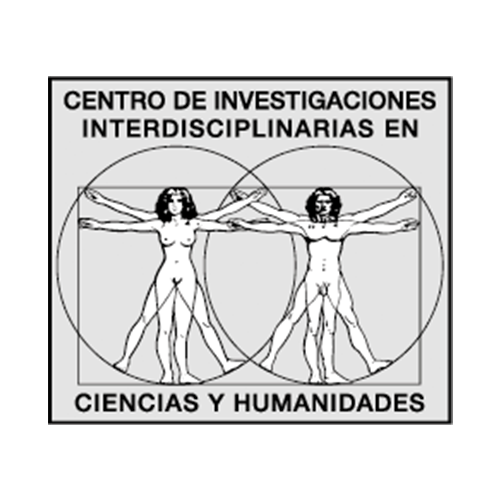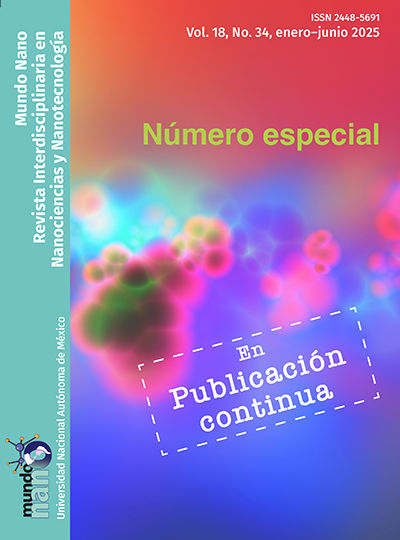Nanopartículas de subsalicilato de bismuto por ablación láser: efecto contra bacterias asociadas a infecciones nosocomiales
Contenido principal del artículo
Resumen
Objetivo: evaluar el efecto antibacteriano de nanopartículas de subsalicilato de bismuto (NPs-SSBi) en contra de cuatro bacterias frecuentemente asociadas con infecciones nosocomiales. Métodos: las NPs-SSBi fueron obtenidas en suspensión coloidal por ablación láser de sólidos en líquidos (ALSL). El tamaño, composición y estabilidad de las NPs en suspensión se analizó por microscopía electrónica de transmisión y espectroscopía ultravioleta-visible. El crecimiento planctónico y la formación de biopelícula de dos bacterias Gram-positivas, S. aureus y S. epidermidis, y dos Gram-negativas, E. coli y P. aeruginosa, después de ser expuestas a diferentes concentraciones de NPs-SSBi (1.25 a 90 μg/mL), se evaluó por ensayos de turbidez y XTT, respectivamente. Resultados: se obtuvieron NPs-SSBi cristalinas de forma cuasi-esférica, con un tamaño de 4.5 ± 0.14 nm, las cuales permanecen estables en suspensión coloidal por al menos 21 días. Las NPs-SSBi inhibieron el crecimiento de las cuatro bacterias, el crecimiento planctónico se redujo ≈80-92% a concentraciones por arriba de 40 μL/mL, y la formación de biopelícula ≈73-89% a concentraciones de 80 y 90 μL/mL. Conclusiones: las NPs-SSBi obtenidas por ALSL inhibieron el crecimiento de cuatro importantes bacterias nosocomiales, por lo cual podrían ser utilizadas para el control de infecciones asociadas con la atención a la salud.
Descargas
Detalles del artículo

Mundo Nano. Revista Interdisciplinaria en Nanociencias y Nanotecnología, editada por la Universidad Nacional Autónoma de México, se distribuye bajo una Licencia Creative Commons Atribución-NoComercial 4.0 Internacional.
Basada en una obra en http://www.mundonano.unam.mx.
Citas
Alharbi, S. A., Mashat, B. H., Al-Harbi, N. A., Wainwright, M., Aloufi, A. S. y Alnaimat, S. (2012). Bismuth-inhibitory effects on bacteria and stimulation of fungal growth in vitro. Saudi Journal of Biological Sciences, 19(2): 147-150. https://doi.org/10.1016/j.sjbs.2012.01.006. DOI: https://doi.org/10.1016/j.sjbs.2012.01.006
Allegranzi, B., Nejad, S. B., Combescure, C., Graafmans, W., Attar, H., Donaldson, L. y Pittet, D. (2011). Burden of endemic health-care-associated infection in developing countries: systematic review and meta-analysis. The Lancet, 377(9761): 228-241. https://doi.org/10.1016/S0140-6736(10)61458-4. DOI: https://doi.org/10.1016/S0140-6736(10)61458-4
Arena, J. (1974). Poisoning. Toxicology, symptoms, treatments. (American lecture series, 1019: American lectures in living chemistry). EUA: Universidad de Míchigan.
Badireddy, A. R., Hernández-Delgadillo, R., Sánchez-Nájera, R. I., Chellam, S. y Cabral-Romero, C. (2014). Synthesis and characterization of lipophilic bismuth dimercaptopropanol nanoparticles and their effects on oral microorganisms growth and biofilm formation. Journal of Nanoparticle Research, 16(6): 2456. https://doi.org/10.1007/s11051-014-2456-5. DOI: https://doi.org/10.1007/s11051-014-2456-5
Bagchi, D., McGinn, T. R., Ye, X., Balmoori, J., Bagchi, M., Stohs, S. J., Kuszynski, C. A., Carryl, O. R. y Mitra, S. (1999). Mechanism of gastroprotection by bismuth subsalicylate against chemically induced oxidative stress in cultured human gastric mucosal cells. Dig Dis Sci, 44(12): 2419-2428. https://doi.org/10.1023/a:1026618501729. DOI: https://doi.org/10.1016/S0016-5085(98)80251-5
Braissant, O., Astasov-Frauenhoffer, M., Waltimo, T. y Bonkat, G. (2020). A review of methods to determine viability, vitality, and metabolic rates in microbiology. Frontiers in Microbiology, 11: 547458. DOI: https://doi.org/10.3389/fmicb.2020.547458
Budavari, S. (ed.). (1996). The Merck index: an encyclopedia of chemicals, drugs, and biologicals, 12a ed. New Jersey, EUA: Merck Research Laboratories.
Cornick, N. A., Silva, M. y Gorbach, S. L. (1990). In vitro antibacterial activity of bismuth subsalicylate. Rev Infect Dis, 12(Supl. 1): S9-10. https://doi.org/10.1093/clinids/12.supplement_1.s9. DOI: https://doi.org/10.1093/clinids/12.Supplement_1.S9
Costerton, J. W., Stewart, P. S. y Greenberg, E. P. (1999). Bacterial biofilms: a common cause of persistent infections. Science, 284(5418): 1318-1322. https://doi.org/10.1126/science.284.5418.1318. DOI: https://doi.org/10.1126/science.284.5418.1318
Dalgaard, P., Ross, T., Kamperman, L., Neumeyer, K. y McMeekin, T. A. (1994). Estimation of bacterial growth rates from turbidimetric and viable count data. International Journal of Food Microbiology, 23(3): 391-404. https://doi.org/10.1016/0168-1605(94)90165-1. DOI: https://doi.org/10.1016/0168-1605(94)90165-1
Dodge, A. G. y Wackett, L. P. (2005). Metabolism of bismuth subsalicylate and intracellular accumulation of bismuth by Fusarium sp. strain BI. Appl Environ Microbiol, 71(2): 876-882. https://doi.org/10.1128/AEM.71.2.876-882.2005. DOI: https://doi.org/10.1128/AEM.71.2.876-882.2005
Domenico, P., Landolphi, D. R. y Cunha, B. A. (1991). Reduction of capsular polysaccharide and potentiation of aminoglycoside inhibition in Gram-negative bacteria by bismuth subsalicylate. J Antimicrob Chemother, 28(6): 801-810. https://doi.org/10.1093/jac/28.6.801. DOI: https://doi.org/10.1093/jac/28.6.801
Flemming, H.-C. y Wingender, J. (2010). The biofilm matrix. Nature Reviews Microbiology, 8(9): 623-633. https://doi.org/10.1038/nrmicro2415. DOI: https://doi.org/10.1038/nrmicro2415
Flores-Castañeda, M., González, E. C., Ruiz-Aguilar, I., Camps, E., Cruces, M. P., Pimentel, E. y Camacho-López, M. (2019). Preparation and characterization of organic nanoparticles by laser ablation in liquids technique and their biological activity. Materials Research Express, 6(10): 105091. https://doi.org/10.1088/2053-1591/ab3cf1. DOI: https://doi.org/10.1088/2053-1591/ab3cf1
Gómez Muñoz, C., Valdés Castro, R., Rodríguez Sánchez, Y. y Figueroa Moreno, R. (2023). Disertación del Boletín Infecciones Asociadas con la Atención de la Salud, agosto 2022. Medicina Interna de México, 39(5). https://doi.org/10.24245/mim.v39i5.8403.
Gosselin, R. H., H. C., Smith, R. P., Gleason, M. N. (1976 ). Clinical toxicology of commercial products. Acute poisoning. Baltimore, M.D.: Williams & Wilkins.
Habashi, F. (2013). Bismuth, physical and chemical properties. En R. H. Kretsinger, V. N. Uversky y E. A. Permyakov (eds.), Encyclopedia of metalloproteins. Nueva York: Springer, 283-284. https://doi.org/10.1007/978-1-4614-1533-6_413. DOI: https://doi.org/10.1007/978-1-4614-1533-6_413
Hajipour, M. J., Fromm, K. M., Akbar Ashkarran, A., Jiménez de Aberasturi, D., Larramendi, I. R. d, Rojo, T., Serpooshan, V., Parak, W. J. y Mahmoudi, M. (2012). Antibacterial properties of nanoparticles. Trends in Biotechnology, 30(10): 499-511. https://doi.org/10.1016/j.tibtech.2012.06.004. DOI: https://doi.org/10.1016/j.tibtech.2012.06.004
Ibrahimkutty, S., Wagener, P., Rolo, T. D. S., Karpov, D., Menzel, A., Baumbach, T., Barcikowski, S. y Plech, A. (2015). A hierarchical view on material formation during pulsed-laser synthesis of nanoparticles in liquid. Scientific Reports, 5(1): 16313. https://doi.org/10.1038/srep16313. DOI: https://doi.org/10.1038/srep16313
Kappstein, I. y Engels, I. (1987). Antibacterial activity of sucralfate and bismuth subsalicylate in simulated gastric fluid. Eur J Clin Microbiol, 6(2): 216-217. http://www.ncbi.nlm.nih.gov/pubmed/3595590. DOI: https://doi.org/10.1007/BF02018225
Koulinska, I., Riester, K., Chalkias, S. y Edwards, M. R. (2018). Effect of bismuth subsalicylate on gastrointestinal tolerability in healthy volunteers receiving oral delayed-release dimethyl fumarate: PREVENT, a randomized, multicenter, double-blind, placebo-controlled study. Clin Ther, 40(12): 2021-2030 e2021. https://doi.org/10.1016/j.clinthera.2018.10.013. DOI: https://doi.org/10.1016/j.clinthera.2018.10.013
Lambert, J. R. y Midolo, P. (1997). The actions of bismuth in the treatment of Helicobacter pylori infection. Aliment Pharmacol Ther, abril 11(Supl. 1): 27-33. https://doi.org/10.1046/j.1365-2036.11.s1.13.x. DOI: https://doi.org/10.1046/j.1365-2036.11.s1.13.x
Lewis, R. J. (2007). Hawley’s condensed chemical dictionary, 12a ed., vol. 129. American Chemical Society. https://doi.org/10.1021/ja0769144.
Li, R. C., Nix, D. E. y Schentag, J. J. (1993). New turbidimetric assay for quantitation of viable bacterial densities. Antimicrobial Agents and Chemotherapy, 37(2): 371-374. https://doi.org/doi:10.1128/aac.37.2.371. DOI: https://doi.org/10.1128/AAC.37.2.371
Mafune, F., Kohno, J., Takeda, Y., Kondow, T. y Sawabe, H. (2000). Formation and size control of silver nanoparticles by laser ablation in aqueous solution. J. Phys. Chem. B, 104(39): 9111-9117. https://doi.org/10.1021/jp001336y. DOI: https://doi.org/10.1021/jp001336y
Magill, S. S., Edwards, J. R., Bamberg, W., Beldavs, Z. G., Dumyati, G., Kainer, M. A., ... y Fridkin, S. K. (2014). Multistate point-prevalence survey of health care–associated infections. New England Journal of Medicine, 370(13): 1198-1208. https://doi.org/10.1056/NEJMoa1306801. DOI: https://doi.org/10.1056/NEJMoa1306801
Mira, P., Yeh, P. y Hall, B. G. (2022). Estimating microbial population data from optical density. PLOS ONE, 17(10): e0276040. https://doi.org/10.1371/journal.pone.0276040. DOI: https://doi.org/10.1371/journal.pone.0276040
OMS. (2022). OMS publica el primer informe mundial sobre prevención y control de infecciones (PCI). https://www.who.int/es/news/item/06-05-2022-who-launches-first-ever-global-report-on-infection-prevention-and-control.
Pitz, A. M., Park, G. W., Lee, D., Boissy, Y. L. y Vinje, J. (2015). Antimicrobial activity of bismuth subsalicylate on Clostridium difficile, Escherichia coli O157:H7, norovirus, and other common enteric pathogens. Gut Microbes, 6(2): 93-100. https://doi.org/10.1080/19490976.2015.1008336. DOI: https://doi.org/10.1080/19490976.2015.1008336
Purvis, J. E. (1926). CV.—The absorption spectra of various derivatives of salicylic acid. Journal of the Chemical Society (Resumed), 129(0): 775-778. https://doi.org/10.1039/JR9262900775. DOI: https://doi.org/10.1039/JR9262900775
Radzig, M. A., Nadtochenko, V. A., Koksharova, O. A., Kiwi, J., Lipasova, V. A. y Khmel, I. A. (2013). Antibacterial effects of silver nanoparticles on Gram-negative bacteria: Influence on the growth and biofilms formation, mechanisms of action. Colloids and Surfaces B: Biointerfaces, 102: 300-306. https://doi.org/10.1016/j.colsurfb.2012.07.039. DOI: https://doi.org/10.1016/j.colsurfb.2012.07.039
Reyes-Carmona, L., Camps, E., Campos-González, E., Mercado-Celis, G., Cervantes-Garduño, A., Pérez-Ibarra, E. A., Álvarez-Chimal, R., Rodil, S. E. y Almaguer-Flores, A. (2023). Antimicrobial evaluation of bismuth subsalicylate nanoparticles synthesized by laser ablation against clinical oral microorganisms. Optics & Laser Technology, 158: 108930. https://doi.org/10.1016/j.optlastec.2022.108930. DOI: https://doi.org/10.1016/j.optlastec.2022.108930
Roehm, N. W., Rodgers, G. H., Hatfield, S. M. y Glasebrook, A. L. (1991). An improved colorimetric assay for cell proliferation and viability utilizing the tetrazolium salt XTT. J Immunol Methods, 142(2): 257-265. https://doi.org/10.1016/0022-1759(91)90114-u. DOI: https://doi.org/10.1016/0022-1759(91)90114-U
Semaltianos, N. G., Hendry, E., Chang, H., Wears, M. L., Monteil, G., Assoul, M., Malkhasyan, V., Blondeau-Patissier, V., Gauthier-Manuel, B. y Moutarlier, V. (2016). ns or fs pulsed laser ablation of a bulk InSb target in liquids for nanoparticles synthesis. J Colloid Interfaces, (469): 57-62. https://doi.org/10.1016/j.jcis.2016.01.069. DOI: https://doi.org/10.1016/j.jcis.2016.01.069
Sox, T. E. y Olson, C. A. (1989). Binding and killing of bacteria by bismuth subsalicylate. Antimicrob Agents Chemother, 33(12): 2075-2082. https://doi.org/10.1128/aac.33.12.2075. DOI: https://doi.org/10.1128/AAC.33.12.2075
USGS. (2021). Mineral commodity summaries 2021. Report. Mineral Commodity Summaries, Issue. U. S. G. Survey. https://pubs.usgs.gov/publication/mcs2021.
Vega-Jiménez, A., Berea-Montes, E. y Almaguer-Flores, A. (2012). Susceptibility of E. coli, P. aeruginosa, S. aureus and S. epidermidis to different bismuth compounds. MRS Proceedings, 1487. DOI: https://doi.org/10.1557/opl.2012.1525
Vega-Jiménez, A. L., Almaguer-Flores, A., Flores-Castañeda, M., Camps, E., Uribe-Ramírez, M., Aztatzi-Aguilar, O. G. y De Vizcaya-Ruiz, A. (2017). Bismuth subsali - cylate nanoparticles with anaerobic antibacterial activity for dental applications. Nanotechnology, 28(43): 435101. https://doi.org/10.1088/1361-6528/aa8838. DOI: https://doi.org/10.1088/1361-6528/aa8838
Yakoob, J., Abbas, Z., Usman, M. W., Awan, S., Naz, S., Jafri, F., Hamid, S. y Jafri, W. (2014). Comparison of antimicrobial activity of zinc chloride and bismuth subsalicylate against clinical isolates of Helicobacter pylori. Microb Drug Resist, 20(4): 305-309. https://doi.org/10.1089/mdr.2013.0086. DOI: https://doi.org/10.1089/mdr.2013.0086
Yang, G. W. (ed.). (2012). Laser ablation in liquids. Principles and applications in the preparation of nanomaterials. Nueva York: Jenny Stanford Publishing, 1192 pp. https://doi.org/Book_Doi 10.1201/B11623. DOI: https://doi.org/10.1201/b11623





